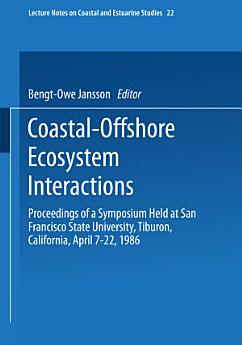Coastal-Offshore Ecosystem Interactions: Proceedings of a Symposium sponsored by SCOR, UNESCO, San Francisco Society, California Sea Grant Program, and U.S. Dept. of Interior, Mineral Management Service held at San Francisco State University, Tiburon, California, April 7–22, 1986
Bengt-Owe Jansson
nov 2013 · Coastal and Estuarine Studies Libro 22 · Springer Science & Business Media
eBook
367
Páginas
reportLas valoraciones y las reseñas no se verifican. Más información
Información sobre este eBook
stable isotope ratios act as naturally-occurring tracers for organic matter, making possible, under certain conditions, the quantification of coastal-offshore exchanges. In general, organic matter has isotope ratios characteristic of its origin (e. g. plants with different modes of photosynthesis and different growth conditions, anthropogenic compounds). These ratios are maintained as the organic matter moves through the biosphere and geosphere. A mixture of organic matter from two sources has isotope ratios intermediate between those of the two sources, in proportion to the fraction of material from each source. Isotope ratios are one of the few methods which can trace organic matter as it moves through natural ecosystems. Ratios can be measured on both the total organic matter and on particular chemical fractions or compounds. When used on organisms, isotope ratios provide information of organic matter actually assimilated into body tissues, not just material ingested. As with all tools, this method has certain limitations which must be borne in mind when interpreting its results. Firstly, specific environmental conditions must be met. This generally means an ecosystem with a limited and known number of sources of organic matter having different isotope ratios. Two sources with different isotope ratios are ideal; additional sources with other isotope ratios complicate interpretation. Secondly, the difference in isotope ratios of the two sources should be large compared with analytical variability. Thirdly, the ratios within each source should vary as little as possible.
Valorar este eBook
Danos tu opinión.
Información sobre cómo leer
Smartphones y tablets
Instala la aplicación Google Play Libros para Android y iPad/iPhone. Se sincroniza automáticamente con tu cuenta y te permite leer contenido online o sin conexión estés donde estés.
Ordenadores portátiles y de escritorio
Puedes usar el navegador web del ordenador para escuchar audiolibros que hayas comprado en Google Play.
eReaders y otros dispositivos
Para leer en dispositivos de tinta electrónica, como los lectores de libros electrónicos de Kobo, es necesario descargar un archivo y transferirlo al dispositivo. Sigue las instrucciones detalladas del Centro de Ayuda para transferir archivos a lectores de libros electrónicos compatibles.







